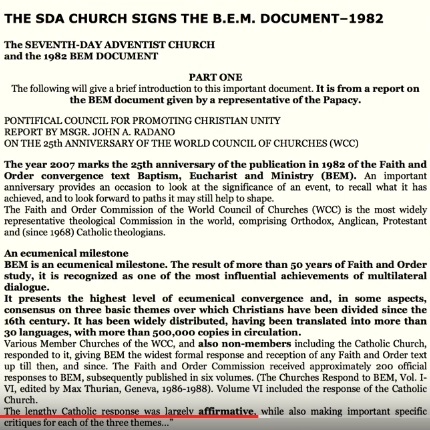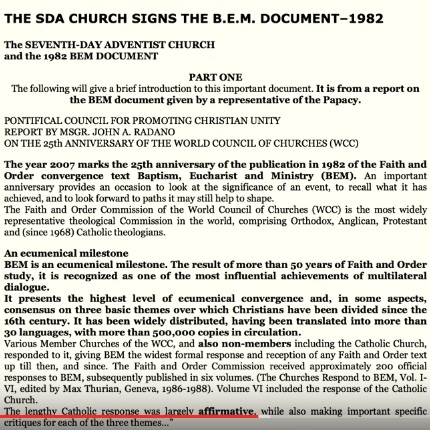
BEM Document
“And have no fellowship with the unfruitful works of darkness, but rather reprove them.”
Ephesians 5:11
SDA Church signs BEM Document--1982
The Seventh Day Adventists Church
and the 1982 BEM DOCUMENT
PART ONE
The following will give a brief introduction to this important document. It is from a report on the BEM document given by a representative of the Papacy.
PONTIFICAL COUNCIL FOR PROMOTING CHRISTIAN UNITY
REPORT BY MSGR. JOHN A. RADANO
ON THE 25th ANNIVERSARY OF THE WORLD COUNCIL OF CHURCHES (WCC)
The year 2007 marks the 25th anniversary of the publication in 1982 of the Faith and Order convergence text Baptism, Eucharist and Ministry (BEM). An important anniversary provides an occasion to look at the significance of an event, to recall what it has achieved, and to look forward to paths it may still help to shape.
The Faith and Order Commission of the World Council of Churches (WCC) is the most widely representative theological Commission in the world, comprising Orthodox, Anglican, Protestant and (since 1968) Catholic theologians.
An ecumenical milestone
BEM is an ecumenical milestone. The result of more than 50 years of Faith and Order study, it is recognized as one of the most influential achievements of multilateral dialogue.
It presents the highest level of ecumenical convergence and, in some aspects, consensus on three basic themes over which Christians have been divided since the 16th century. It has been widely distributed, having been translated into more than 30 languages, with more than 500,000 copies in circulation.
Various Member Churches of the WCC, and also non-members including the Catholic Church, responded to it, giving BEM the widest formal response and reception of any Faith and Order text up till then, and since. The Faith and Order Commission received approximately 200 official responses to BEM, subsequently published in six volumes. (The Churches Respond to BEM, Vol. I-VI, edited by Max Thurian, Geneva, 1986-1988). Volume VI included the response of the Catholic Church.
The lengthy Catholic response was largely affirmative, while also making important specific critiques for each of the three themes…”
(Our note: One other non-member that would sign the BEM document was the Seventh-day Adventist Church).
PART TWO
The next section contains words taken from Spiritism in the Seventh-day Adventist Church, pp. 86-88, by Colin and Russell Standish, Hartland Pub., 1995; and “Capitulation to the Ecumenical Movement,” by Colin Standish:
Every effort is being made to de-emphasize the great pillars of the Christian faith. We cannot forget the congress that convened in Lima, Peru, in 1981, in which almost all of the Christian communions of the world met, including a representative from the Seventh-day Adventist Church.
The representation of the Seventh-day Adventist Church surely hit an all-time low in January of 1982 when the theological representative of the Seventh-day Adventist Church signed what today has become know as the BEM document, sometimes also referred to as the Lima Text, with which readers will probably be unfamiliar. BEM stands for Baptism, Eucharist, and Ministry. This document of the World Council of Churches is the centerpiece of their determination to bring in a one-world religion around the planet.
The synopsis of the purposes of the document are these:
1. Baptism: To encourage all churches to make no issue of the mode of or the age at baptism. If adult consent and decision baptism is practiced by immersion, that is acceptable, as equally is infant sprinkling.
(No authentic Seventh-day Adventist could accept such a proposition. In past ages myriads of God’s faithful people died because they believed in adult believers’ baptism by complete immersion, following in the footsteps of their Saviour, and because they held infant baptism to be wholly unscriptural. How could Seventh-day Adventists ever agree to the equality of one form of baptism, which is predicated upon the words and example of Jesus, and the other one, which has no foundation within the Word of God?)
2. Eucharist: To encourage all to accept equally the various concepts, whether they be trans-substantiation, con-substantiation, or the fact that the bread and wine are symbols of the broken body and spilled blood of Jesus Christ.
(The term Eucharist is certainly not a Protestant term, yet at least in one church in Auckland, New Zealand, and one church in Sydney, Australia, the communion has been referred to in their church bulletin as the Eucharist. This Catholicizing of the Adventist Church is not by accident. It is a deliberate effort to bring us under the banner of the Papacy controlled by Satan.
(When we recognize the absolutely blasphemous claims of the Roman Catholic Church, which claims that the priest is the creator of his Creator, that in the wafer he creates Christ in reality; when one considers the claims that the priest can move Christ here and there, backward and forward, once again no earnest Seventh-day Adventist could ever accept such an abominable compromise. Also myriads of God’s people in the past lost their lives because they refused to accept such blasphemous claims of the Papacy.)
3. Ministry: To encourage all churches to work for the unchurched, but never to proselytize from other churches.
(The acceptance of this agreement would lead to a total capitulation from the final message which we are commissioned by our God to give to the world—the loud cry of Revelation 18:4, “Come out of her, my people, that ye be not partakers of her sins, and that ye receive not of her plagues.” They are to be called out because of God’s great love for them. They must be called out so that they will not continue in the sins of Babylon, and so that they will be protected from the plagues that will come after the close of probation.
Yet today we are hearing voices in the Adventist Church, ministers calling for the same ministry as these ecumenical forces in our world. “Let us work for the unchurched.”)
While we cannot, of course, ignore the unchurched—we must work for them—such statements deny the critical call to work for those who have been trapped in the churches of Catholicism and fallen Protestantism. The back of the BEM document reveals a most startling statement:
“The statement published here marks a major advance in the ecumenical journey. The result of a fifty-year process of study and consultation, this text on Baptism, Eucharist, and Minstry represents a theological convergence that has been achieved thorough decades of dialogue, under the guidance of the Holy Spirit.
“Over 100 theologians met in Lima, Peru in January 1982, and recommended unanimously to transmit this agreed statement—the Lima Text—for the common study and official response of the churches. They represented virtually all the major church traditions: Eastern Orthodox, Oriental Orthodox, Roman Catholic, Old Catholic, Lutheran, Anglican, Reformed, Methodist, United, Disciples, Baptists, Adventists, and Pentecostal.
“The churches’ response to this agreed statement will be a vital step of the ecumenical process of “reception.” (Lima Test, emphasis ours).
Dr. Raoul Dederen, professor at the Seminary at Andrews University, was the Seventh-day Adventist representative at this meeting.
PART THREE
What was the Seventh-day Adventist response to the BEM document? Concerning the Eucharist are these astounding words:
“Recent research clearly reveals that there is no consensus among scholars on some of the most critical issues pertaining to the eucharist….this central celebration of the Christian church….The purpose of this essay is primarily to show how Seventh-day Adventist understanding of the eucharist or the Lord’s supper…[and] to highlight Adventist understanding and practice of the eucharist…
“On occasion Seventh-day Adventists refer to the eucharist as a sacrament….Being conscious of the sacredness of the celebration of the eucharist, Adventists engage in a personal preparation that includes self-examination…In preparation for the celebration of the eucharist Seventh-day Adventists practice the washing of feet…”
(Written response of the Seventh-day Adventist Church Council on Inter-Church Relations, November, 1985, published in Churches Respond to BEM (Baptism, Eucharist, and Ministry), vol 2, p 341-343, published by the World Council of Churches in 1986).
Three years later…
In 1985, the new SDA church Hymnal was published. In it is Hymn No. 402 (By Christ Redeemed): There is a major Catholic error in this hymn as verse two upholds the blasphemous doctrine of transubstantiation in the eucharist: “His broken body in our stead Is here, in this memorial bread.”
This is the false Catholic doctrine that the substance of the bread and wine are changed into the actual flesh and blood of Jesus Christ in the Eucharist, even though the external appearance remains the same. We, as Protestants believe that the communion bread and unfermented grape juice are symbols of Christ flesh and blood. George Rawson, the author of this hymn, did NOT write, Is here, but shown. Who changed the words? Unless there is a public repentance, we can only conclude that the changes reflect current SDA theology.
In 1988, the General Conference published Seventh-day Adventists Believe—27 Fundamental Doctrines. In Statement #16 concerning the Lord’s Supper, it says,
“Among Protestants the most common name for the Communion service is the ‘Lord’s Supper’ (1 Cor. 11:20). Other names are ‘the table of the Lord’ (1 Cor. 10:21, RSV), ‘the breaking of bread’ (cf. Acts 20:7; 2:42), and the Eucharist—a reference to the thanksgiving and blessing aspect of the service (Matt. 26:26,27; 1 Cor. 10:16; 11:24). The Lord’s Supper is to be a joyful season, not a time for sorrow. …What marks those who are qualified to participate in the Communion service, then, is the condition of the heart—a full commitment to Christ and faith in His sacrifice, not membership in any particular church. Consequently, believing Christians of all churches can take part in the Lord’s Supper.” Pp. 198,203.
Here two terms are set side by side as if they were the same—the Lord’s Supper, and the Eucharist. One is true, the other false. The Eucharist is a blasphemy against God, and is as much different from the Lord’s Supper, as black is different from white. But the authors of this book alerted the reader that every time the term “the Lord’s Supper” is used, it could also mean the Eucharist. And probably does. It’s an ecumenical ploy. Two terms are laid side by side, as if they are equal. And when that is allowed, the error always will win out.
May 2, 1991: No wonder in this issue of the Adventist Review, Roy Adams could declare:
“And we could go on if space permitted – to mention the WCC’s… accentuation of the Holy Spirit and the Eucharist. All of these emphases fit into the ambit of the three angels’ messages.”
(The Third Angel’s Message warns that if anyone worships the beast, he will receive the wrath of God poured out without mixture in the seven last plagues. What is the center piece of Catholic worship?–it is the Eucharist. The Eucharist doctrine declares that Christ’s actual body and blood are in the round wafer and fermented wine. Roy Adams must have been drunk on Babylonian wine to make the statement he did.)
TODAY: The following is from a recent local SDA church bulletin:
Hollywood Seventh-day Adventist Church
Where God’s Spirit Is Given Space To Change Lives
COMMUNION SABBATH
This Sabbath our community celebrates what we call Communion. We hope you’ll join us for this sacred celebration. For our congregation, Communion is made up of the Ordinance of Humility (or, Footwashing - see John 13:1-17) and Eucharist, or the Lord’s Supper.
The scripture for this Sabbath is Mark 12:28-34. Why not spend some time with this text this week before coming to church.
PART FOUR: A CALL TO REPENT
We call on the General Conference of S.D.A. to repent of the ecumenical apostasy, which is leading the Seventh-day Adventist church to Rome.
If it does not repent, individual Seventh-day Adventists must stay with the truth of the Three Angels’ Messages of Rev. 14:6-12, and separate from this corporate sin.
2 Corinthians 6:14-18



